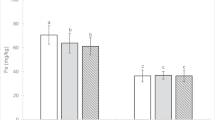Abstract
In a multidisciplinary study, highly significant interactional effects were found among land use, livestock component, soil properties and rainfall. On an average, 16.2 to 82.2 tonnes of sediment yield km−2 and more than 90% of rainwater was retained in-situ in new land use systems as against 3621.3 tonnes of sediment and 66.3% rainwater retention in shifting cultivation, because of poor land cover. Good vegetation cover reduced the runoff load, resulting in significant reduction in the soil and nutrient erosion. The average sediment yield was only 0.44%, 2.68%, 1.47%, 0.31%, 0.73% and 2.27% in livestock based, forestry, agro-forestry, agriculture, agri-horti-silvi-pastoral and horticulture land use systems of that of shifting cultivation. Highest average sediment yield was 704.3 t km−2 when the annual rainfall was 2770 mm and minimum 405.4 t km−2 when the annual rainfall was 1992 mm. More in-situ retention of rainwater helped in the availability of adequate moisture from the soil to the succeeding crops when the rainy season receded. The sediment yield varied according to the rainfall received during a particular year and the nature of vegetation in a particular land use. There was sufficient fertility build-up in the watersheds where animals were kept and after ten years of start of the study, no need of inorganic sources of nutrients was required. The organic carbon, humus, exchangeable calcium, magnesium, potassium and available phosphorus increased significantly in the new land use systems compared to shifting cultivation, however, the DTPA (Diethylene triamine penta acetic acid) extractable zinc, copper, iron and exchangeable aluminium decreased over the initial soil status. It showed that the vegetation in the new land uses had a smothering effect on the soil and increase in the elements had a favourable impact on the crop productivity.
Similar content being viewed by others
References
Bosch J.M. & Hewlett J.D. 1982. A review of catchment experiments to determine the effect of vegetation changes on water yield and evapotranspiration. J. Hydrol. 55: 3–23.
Jackson M.L. 1973. Soil Chemical Analysis. Parentice Hall of India, New Delhi, India.
Murty D., Kirschbaum M.U.F., McMurtrie R.E. & McGillvray H. 2002. Does Conservation of forest to agricultural land change soil carbon and nitrogen: A review of the literature. Global Change Biol. 8: 105–123.
Niehoff D., Fritsch U. & Bronstert A. 2002. Land use impacts on storm-runoff generation: scenarios of land use change and simulation of hydrological response a meso-scale catchment in SW Germany. J. Hydrol. 267: 80–93.
Powell A. 2004. Will ecology provide the next major advance in freshwater science, pp. 267–273. In: Rodda J.C. & Ubertini L. (eds), The Basis of Civilization-Water Science. IAHS Publ. 286. IAHS Press, Wallingford, UK.
Sharma U.C. 2001. Effect of farming system type on in-situ ground water recharge and quality in northeast India, pp. 167–169. In: Gehrels H., Peters N.E., Hoehn E., Jenson K., Leibundgut C., Griffioen J., Webb B. & Zaadnoordijk W. J. (eds), Impact of human Activity on Groundwater Dynamics, IAHS Publ. no. 269. IAHS Press, Wallingford, UK.
Sharma U.C. 2003. Impact of population growth and climate change on the quantity and quality of water resources in the northeast of India, pp. 240–247. In: Bloschl G., Franks S., Kumagai M., Musiake K & Rosbjerg J. (eds), Water Resources Systems - Hydrological Risks, Management and Development, IAHS Publ. No. 281. IAHS Press, Wallingford, UK.
Sharma U.C. & Prasad R.N. 1995. Socio-economic aspects of acid soil management and alternate land use systems for northeastern states of India, pp. 689–695. In: Date R.A., Grundon N.J., Rayment G.E. & Probert M.E. (eds), Plant-Soil Interactions at Low pH, Kluwer Academic Press, The Netherlands.
Singh B.P. & Das M. 1993. Annual Report, ICAR Research Complex for Northeastern Region, Shillong, Meghalaya, India.
Singh B.P., Das M. & Sharma U.C. 1991. Annual Report, ICAR Research Complex for Northeastern Region, Shillong, Meghalaya, India.
Author information
Authors and Affiliations
Corresponding author
Rights and permissions
About this article
Cite this article
Sharma, U.C., Sharma, V. Plant-livestock-soil-hydrology interactions in the northeastern region of India. Biologia 64, 560–564 (2009). https://doi.org/10.2478/s11756-009-0105-8
Received:
Accepted:
Published:
Issue Date:
DOI: https://doi.org/10.2478/s11756-009-0105-8




